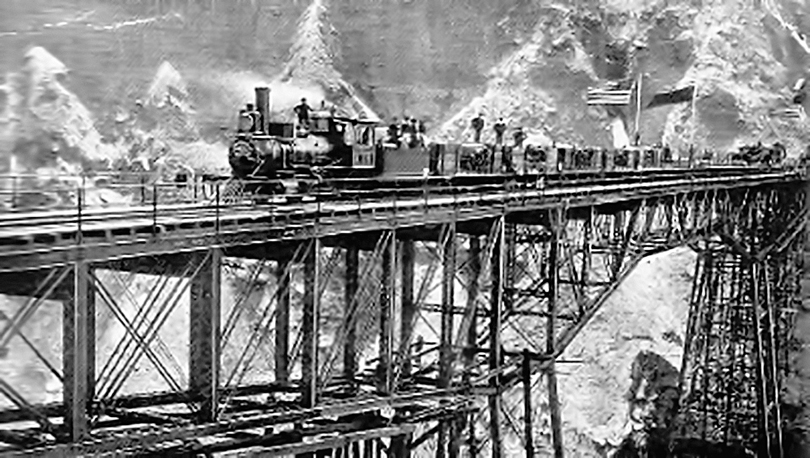A History of World Societies:
Printed Page 834
A History of World Societies Value
Edition: Printed Page 844
Individuals in Society
Henry Meiggs, Promoter and Speculator
Individuals in Society
Henry Meiggs, Promoter and Speculator
ALL THROUGHOUT THE AMERICAS IN THE nineteenth century, opportunities beckoned. Henry Meiggs, born in upstate New York in 1811, responded to several of them, building and losing fortunes in Brooklyn, San Francisco, Chile, and Peru.
Meiggs, with only an elementary school education, began work at his father’s shipyard. He soon started his own lumber business and did well until he lost everything in the financial panic of 1837. He rebuilt his business, and when gold was discovered in California in 1848, he filled a ship with lumber and sailed around Cape Horn to San Francisco, where he sold his cargo for $50,000, twenty times what he had paid for it. He then entered the lumber business, organizing crews of five hundred men to fell huge California redwoods and bring them to his steam sawmills. As his business flourished, he began speculating in real estate, which led to huge debts when the financial crisis of 1854 hit. In an attempt to save himself and his friends, Meiggs forged warrants for more than $900,000; when discovery of the fraud seemed imminent, he sailed with his wife and children for South America.
Although at one point Meiggs was so strapped for cash that he sold his watch, within three years of arriving in Chile, he had secured his first railway contract, and by 1867 he had built about 200 miles of rail lines in that country. In 1868 he went to Peru, which had less than 60 miles of track at the time. In the next nine years he would add 700 more.
Meiggs was not an engineer, but he was a good manager. He recruited experienced engineers from abroad and arranged the purchase of foreign rolling stock, rails, and ties, acting as a promoter and developer. Much of the funding came from international investors in Peruvian bonds.
The most spectacular of the rail lines Meiggs built was Peru’s Callao-
In Peru Meiggs became known for his extravagance and generosity, and some charged that he bribed Peruvian officials on a large scale to get his projects approved. He was a good speaker and loved to entertain lavishly. In one example of his generosity, he distributed thousands of pesos and soles to the victims of the earthquake of 1868. He also contributed to the beautification of Lima by tearing down an old wall and putting a seven-

Always the speculator, in 1877 Meiggs died poor, his debts exceeding his assets. He was beloved, however, and more than twenty thousand Peruvians, many of whom had labored on his projects, attended his funeral at a Catholic church in Lima.
QUESTIONS FOR ANALYSIS
- What accounts for the changes in fortune that Meiggs experienced?
- Were the Latin American governments that awarded contracts to Meiggs making reasonable decisions?
- Should it matter whether Meiggs had to bribe officials to get the railroads built? Why or why not?
Document Project
How did investors like Henry Meiggs fit into the larger context of Latin American nation building? Read descriptions of Latin America’s past and visions of its future, and then complete a quiz and writing assignment based on the evidence and details from this chapter.